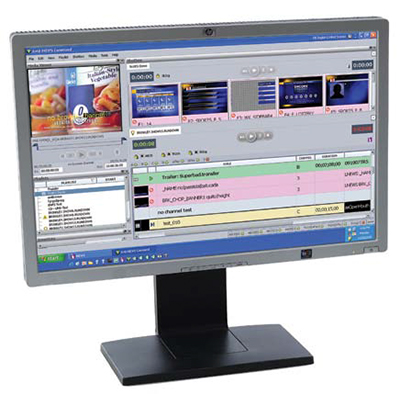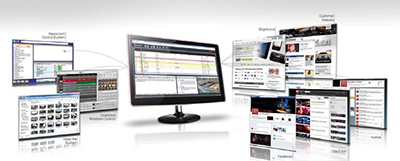Clouds and Crowds in the Newsroom

Avid’s INews Command screen is a familiar tool found in many TV newsrooms.
CAMDENTON, MO.—The acronym for newsroom computer systems, NRCS, was coined when most reporters were proud of their IBM Selectrics. Since then, a number of manufacturers have introduced newsroom systems which have gained market share. The NRCS acronym is fading, but the concept was exactly what the TV news business needed. Just as no two local TV newsrooms are the same, neither are newsroom systems.
Some manufacturers make complete turnkey systems while others provide browser-based software that runs on off-the-shelf systems and servers. The opinion among users is that the superior system is the one that fits the newsroom.
The question is, where the intelligence and workflow management resides as it relates to news and multiplatform distribution. Typically, TV newsrooms use multiplatform news systems such as AP’s Electronic News Production System, Avid’s iNEWS, Dalet’s News Suite, Ross Video’s Inception News, Octopus’ Octopus7 or Playbox’s NewsRoomBox, which the company launched at the 2013 IBC Show. All are designed to produce content for broadcast news, web, mobile and social media.
While the NRCS is the script and rundown manager, digital media is dependent on pre- and post-production video-on-demand, live streaming with content replacement and 24/7 streaming channels with live cut-ins. In this scenario, the NRCS becomes the show architect and the program clock reference becomes the processing engine with exact segmentation break points for story and event-level metadata and clip parsing for video-on-demand and SCTE messaging for live streaming content replacement.
This suggests the digital news production system is the most logical workflow manager where content is edited, produced, published and associated with social media or replacement content in the case of embargoed material. It can also be linked to extended play segments in the case of companion apps to further augment the user experience and engage the consumer with more in-depth stories and interactivity.
Some portable turnkey production systems built specifically to integrate with news systems also are becoming quite popular. Among them are Bitcentral’s CORE:news and EVS’ Xedio.
The professional video industry's #1 source for news, trends and product and tech information. Sign up below.

Ross Video Inception Newsroom is a complete newsroom computer system.
There are many selections and combinations. Purchasing, leasing and support expenses vary widely. Choose your system and vendor with diligence. Your future depends on it.
STREAMLINED STREAMS
New technology driving newsroom solutions has always focused on efficiency. As needs and opportunities for broader content distribution and reporting increase, so do efficiency opportunities. Where the single basic TV screen once stood as a monolith, now there are multiple screens, all hungry for compelling content often on demand anywhere.
A station’s website is a huge part of a local broadcaster’s footprint. For some viewers, it may be their primary source of local news. Delivering highly rated newscasts several times a day on TV has always been mission-critical, but today’s success track is cross-promotion and fulfilling the needs of the audience on their media of choice of the moment. Viewers are moving as fast as the news; technical facilities must move faster.
One benefit of Internet content delivery is analytic feedback. Visitors are more clearly identified and defined, enabling stations and advertisers to customize content. ATSC is a simple one-way stream available in realtime to any and all viewers. Streaming IP requires adequate infrastructure to support two-way communication with each unique viewer.
Another early headache of broader content distribution was that more screens required more streaming formats. Player progress and automatic format conversion in the background makes the work invisible, but where the converted files reside will ultimately determine their fate. When huge stories break, some local TV stations have learned that local storage can get jammed with too much traffic. Is the “cloud” a solution?
The cloud describes an unspecified number of computers on a single real-time network such as the internet, typically sharing files. Cloud computing allows multiple computers to simultaneously share a single application and associated files over a network. For TV broadcasters, the cloud and cloud computing are tools.
There are big-brand public clouds such as Apple’s iCloud, Netflix or Amazon Cloud, and countless lower-profile private clouds designed and built specifically for storage and bandwidth-hungry uses including television and video production. TV broadcasters are understandably reluctant to hand over the newsroom jewels to a third party, so some are developing their own private group clouds. Group clouds have a number of distinct advantages, including, but not limited to, centralized maintenance and security.
Group clouds provide instantaneous private media and data sharing between group stations, allowing groups to manage assets and metadata more efficiently. A group cloud can also provide peak-load headroom during breaking local news scenarios that could swamp smaller systems. They make sense in a growing data-centric environment. Some groups already have them, while others are taking a “wait and see” approach.
The cloud can give news people the ability to edit content on their desktops, laptops, tablets or smartphones instead of in a dedicated edit suite. Finished content can be sent directly to station video servers over IP while on location or en route, without a TV set or video gear. Avid calls their vision of the concept Avid Everywhere, while Adobe’s Adobe Anywhere is also growing in popularity.
Group clouds also work into various centralcasting models. A group cloud can facilitate the combining of repetitive work across a smaller group of people. One group station, for example, might eliminate local graphics departments by providing group graphic design services and building all group news graphics templates. Similarly, another group station might verify all metadata and segment timings before forwarding guaranteed accurate content files to group stations. Another station could perform all group traffic functions for the group, while another station does all group billing. Consolidating repetitive work makes business sense. The cloud appears to be the answer, but the question is which one.
